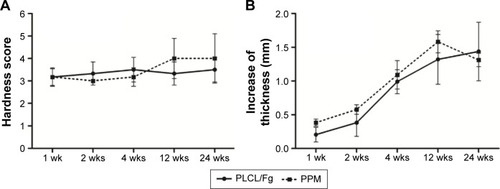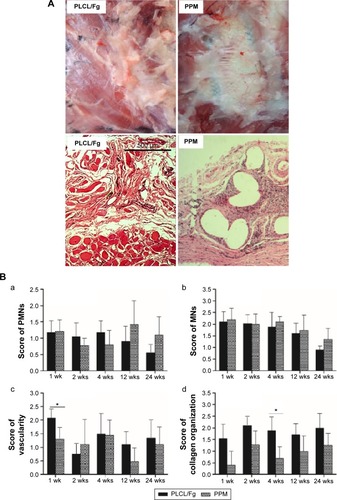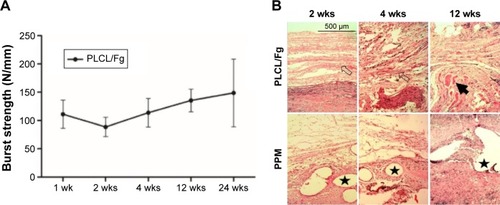Figures & data
Table 1 Scoring criteria for microscopic evaluation
Figure 1 Hardness and thickness of PLCL/Fg and PPM at the implant site during 24 weeks of study. (A) Hardness of the PLCL/Fg and PPM after implantation. (B) Increase in thickness of PLCL/Fg and PPM after implantation.
Abbreviations: Fg, fibrinogen; PLCL, poly(l-lactide-co-caprolactone); PPM, polypropylene mesh; wks, weeks.

Figure 2 (A) Representative cross-sections of PLCL/Fg and PPM samples stained with hematoxylin and eosin at 24 weeks time points (scale bar =500 μm, ×40). (B) Histological analysis of PLCL/Fg and PPM after implantation. (a) Average score for the number of polymorphonuclear cells. (b) Average score for the number of mononuclear cells. (c) Amount of vascularity. (d) Degree of collagen organization. *P<0.05.
Abbreviations: Fg, fibrinogen; MNs, mononuclear cells; PLCL, poly(l-lactide-co-caprolactone); PMNs, polymorphonuclear cells; PPM, polypropylene mesh; wks, weeks.

Figure 3 (A) Ball burst strength of PLCL/Fg after implantation for 24 weeks. (B) Representative cross-sections of PLCL/Fg and PPM samples stained with hematoxylin and eosin at 2, 4, and 12 weeks (scale bar =500 μm, ×40). The mesh structure of PLCL/Fg is indicated with hollow arrowheads, the regenerated muscle tissues are indicated with solid arrowhead, and the PPM filaments are indicated with stars.
Abbreviations: Fg, fibrinogen; PLCL, poly(l-lactide-co-caprolactone); PPM, polypropylene mesh; wks, weeks.

Table 2 Comparison of operation time and blood loss for PLCL/Fg and PPM groups
Table 3 Comparison of preoperative and postoperative POP-Q of women undergoing repair with PLCL/Fg versus PPM
Table 4 Comparison of 6-month postoperative POP-Q of women undergoing PLCL/Fg and PPM repair
